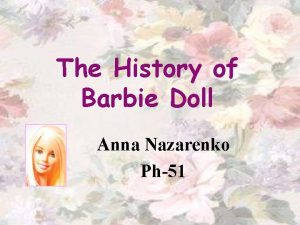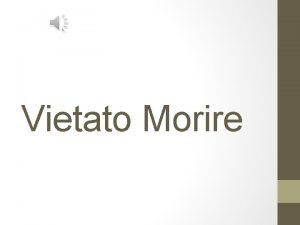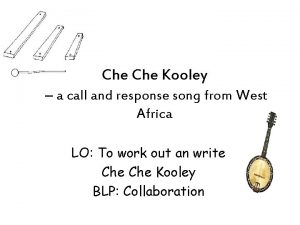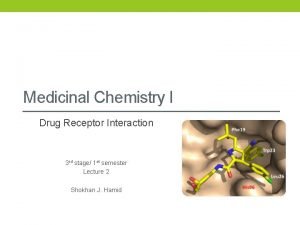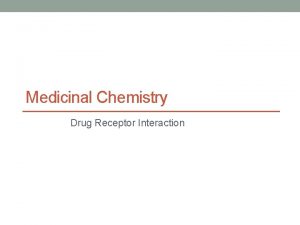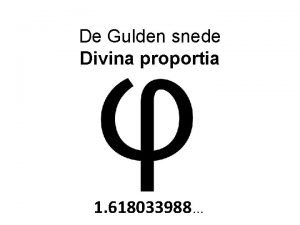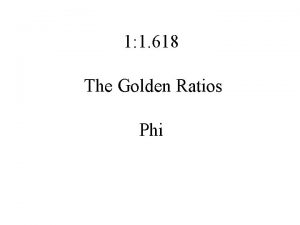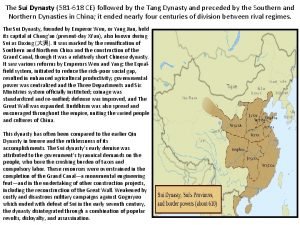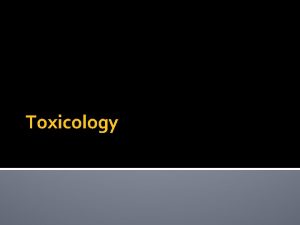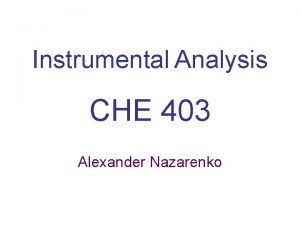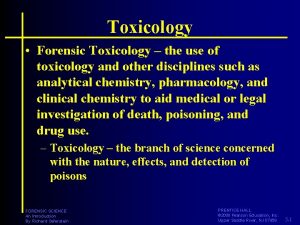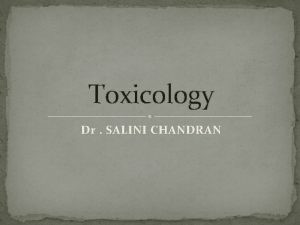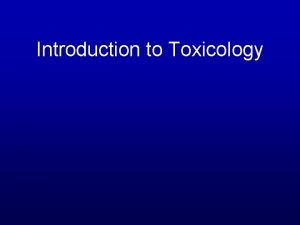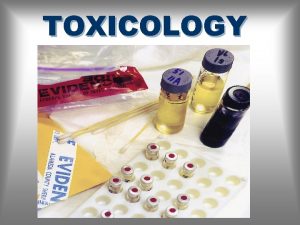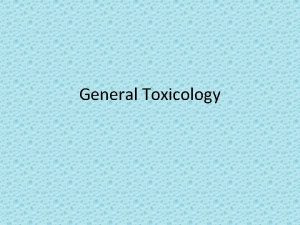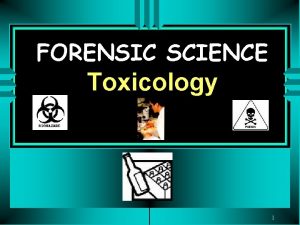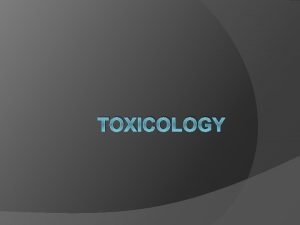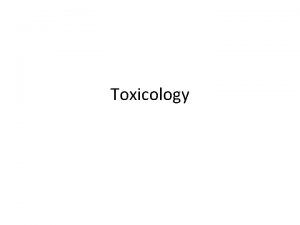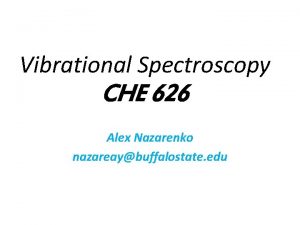Drug Chemistry and Toxicology CHE 618 Alexander Nazarenko






![Drug + Receptor [Drug/Receptor Complex] K Action Drug + Receptor [Drug/Receptor Complex] K Action](https://slidetodoc.com/presentation_image_h2/94d08ef7cd80e0fa195296dccf9694b5/image-7.jpg)




![Full Agonist +1 Functional Response Partial Agonist Neutral Antagonist 0 Full Inverse Agonist Log[Drug] Full Agonist +1 Functional Response Partial Agonist Neutral Antagonist 0 Full Inverse Agonist Log[Drug]](https://slidetodoc.com/presentation_image_h2/94d08ef7cd80e0fa195296dccf9694b5/image-12.jpg)




- Slides: 16

Drug Chemistry and Toxicology CHE 618 Alexander Nazarenko

The Receptor Concept The Nature of Drug Receptors Drug Parameters: Affinity and Efficacy The Langmuir Isotherm equation

Insulin receptor Opioid receptor Transmembrane receptor

Occupation theory Drug effect is directly proportional to number of receptors occupied Drug effect ceases as drug-receptor complex dissociate Ariens & Stephenson theory introduced terms of "affinity" & "efficacy" Affinity: ability of the drug to combine with receptor to create drug-receptor complex Efficacy: ability of the drug-receptor complex to initiate a response Affinity “drug-receptor interaction” is governed by the law of mass action. In this theory Agonist: drug with high affinity & high intrinsic activity Partial agonist: drug with high affinity & low intrinsic activity Antagonist: drug with high affinity & low intrinsic activity Rate theory The activation of receptors is directly proportional to the total number of encounters of the drug with its receptors per unit time Pharmacological activity is directly proportional to the rate of dissociation & association not number of receptors occupied Agonist: drug with fast association & fast dissociation Partial agonist: drug with intermediate association & intermediate dissociation Antagonist: drug with fast association & slow dissociation Induced fit theory As the drug approaches the receptors alters the conformation of its binding site to produce drug—receptor complex

An agonist is a chemical that binds to a receptor and triggers a response. Whereas an agonist causes an action, an antagonist blocks the action of the agonist and an inverse agonist causes an action opposite to that of the agonist. From the Greek αγωνιστής (agōnistēs), contestant; champion; rival < αγων (agōn), contest, combat; exertion, struggle < αγω (agō), I lead, lead towards, conduct; drive

![Drug Receptor DrugReceptor Complex K Action Drug + Receptor [Drug/Receptor Complex] K Action](https://slidetodoc.com/presentation_image_h2/94d08ef7cd80e0fa195296dccf9694b5/image-7.jpg)
Drug + Receptor [Drug/Receptor Complex] K Action

The Langmuir Isotherm β = 100 K = 1/100 = 0. 01

a Various plots 1/a 12 C 10 8 6 0, 04 C/a 0, 035 4 0, 03 2 1/C 0 0 500 1000 0, 025 0, 02 0, 015 0, 01 Lineweaver–Burk plot C 0, 005 0 Hanes–Woolf plot 0

Michaelis–Menten kinetics Lineweaver–Burk or double-reciprocal plot of kinetic data, showing the significance of the axis intercepts and gradient. Michaelis-Menten Plot relating the reaction rate V to the substrate concentration [S].

Agonists Full agonists are able to activate the receptor and result in a maximal biological response. Partial Agonist Partial agonists do not activate receptors thoroughly, causing responses which are partial compared to those of full agonists Antagonists bind to receptors but do not activate them. This results in receptor blockage, inhibiting the binding of other agonists. Inverse Agonist Inverse agonists reduce the activity of receptors by inhibiting their constitutive activity.
![Full Agonist 1 Functional Response Partial Agonist Neutral Antagonist 0 Full Inverse Agonist LogDrug Full Agonist +1 Functional Response Partial Agonist Neutral Antagonist 0 Full Inverse Agonist Log[Drug]](https://slidetodoc.com/presentation_image_h2/94d08ef7cd80e0fa195296dccf9694b5/image-12.jpg)
Full Agonist +1 Functional Response Partial Agonist Neutral Antagonist 0 Full Inverse Agonist Log[Drug] -1

Competitive Antagonism A 1 + Receptor A 2 + Receptor {A 1 Receptor} {A 2 Receptor} effect

A 1 A 2 Receptor-A 1 is active R A 1 R R A 2 Receptor-A 1 -A 2 is active A 2

Similar: In coordination chemistry In enzyme kinetics Metal Ion + Ligand 1 + Ligand 2 Enzyme + Substrate + Inhibitor

Dose-response curve What is there that is not poison? All things are poison and nothing without poison Solely the dose determines that a thing is not a poison
 Anna nazarenko
Anna nazarenko Drug identification and toxicology
Drug identification and toxicology Example of substitution with exhausted drug is
Example of substitution with exhausted drug is Proposizione oggettiva implicita
Proposizione oggettiva implicita La vita che avrai non sarà mai distante dall'amore che dai
La vita che avrai non sarà mai distante dall'amore che dai Che che kooley
Che che kooley Facesti come quei che va di notte che porta il lume
Facesti come quei che va di notte che porta il lume Drug receptor interaction medicinal chemistry
Drug receptor interaction medicinal chemistry Drug receptor interaction medicinal chemistry
Drug receptor interaction medicinal chemistry 618,033,988
618,033,988 +1 618
+1 618 X-618
X-618 Sdah 618
Sdah 618 Sui dynasty founder
Sui dynasty founder Kba compacta 618
Kba compacta 618 Siad mi
Siad mi Ruler of the land 618
Ruler of the land 618
